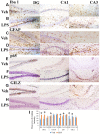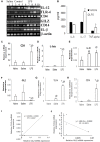Glucocorticoid Induced Leucine Zipper in Lipopolysaccharide Induced Neuroinflammation
- PMID: 30740047
- PMCID: PMC6355683
- DOI: 10.3389/fnagi.2018.00432
Glucocorticoid Induced Leucine Zipper in Lipopolysaccharide Induced Neuroinflammation
Abstract
Glucocorticoids (GCs) are steroid hormones secreted as the end-product of the neuroendocrine stress cascade. Both absence and elevated GC mediate neurotoxic responses, suggesting that a narrow window ranging from physiological to slightly high GC mediate protective responses. The beneficial effects of GC are attributed to the transactivation of regulatory proteins and inhibition mediated by glucocorticoid receptor (GR) interactions with other co-factors. The glucocorticoid induced leucine zipper (GILZ) is a gene strongly upregulated by GC and mediates many of the anti-inflammatory and anti-proliferative effects of GC. Although GILZ is constitutively expressed in many tissues including the brain, the expression has been shown to occur with varying dynamics suggesting that the local milieu modulates its expression with consequent effects on cellular responses. Here we investigated the expression profile of GILZ in lipopolysaccharide (LPS) mediated neuroinflammation model of Alzheimer's disease (AD). Our data suggest that the GILZ expression is downregulated in neuroinflammation correlating inversely with the pro-inflammatory cytokines and innate immune responses.
Keywords: Alzheimer’s disease; cytokines; glucocorticoid induced leucine zipper; neuroinflammation; toll like receptor-4.
Figures


Similar articles
-
Glucocorticoid-Induced Leucine Zipper in Central Nervous System Health and Disease.Mol Neurobiol. 2017 Dec;54(10):8063-8070. doi: 10.1007/s12035-016-0277-5. Epub 2016 Nov 26. Mol Neurobiol. 2017. PMID: 27889894 Free PMC article. Review.
-
[GILZ (glucocorticoid-induced leucine zipper), a mediator of the anti-inflammatory and immunosuppressive activity of glucocorticoids].Ann Ig. 2010 Jan-Feb;22(1 Suppl 1):53-9. Ann Ig. 2010. PMID: 20701225 Italian.
-
Glucocorticoid-Induced Leucine Zipper: A Novel Anti-inflammatory Molecule.Front Pharmacol. 2019 Mar 27;10:308. doi: 10.3389/fphar.2019.00308. eCollection 2019. Front Pharmacol. 2019. PMID: 30971930 Free PMC article. Review.
-
Glucocorticoid-induced leucine zipper (GILZ) is involved in glucocorticoid-induced and mineralocorticoid-induced leptin production by osteoarthritis synovial fibroblasts.Arthritis Res Ther. 2016 Oct 4;18(1):219. doi: 10.1186/s13075-016-1119-6. Arthritis Res Ther. 2016. PMID: 27716396 Free PMC article.
-
Formoterol counteracts the inhibitory effect of cigarette smoke on glucocorticoid-induced leucine zipper (GILZ) transactivation in human bronchial smooth muscle cells.Eur J Pharmacol. 2019 May 5;850:8-14. doi: 10.1016/j.ejphar.2019.02.010. Epub 2019 Feb 10. Eur J Pharmacol. 2019. PMID: 30753866
Cited by
-
Young adult and aged female rats are vulnerable to amygdala-dependent, but not hippocampus-dependent, memory impairment following short-term high-fat diet.Brain Res Bull. 2023 Apr;195:145-156. doi: 10.1016/j.brainresbull.2023.03.001. Epub 2023 Mar 2. Brain Res Bull. 2023. PMID: 36870621 Free PMC article. Review.
-
Implicating the Role of GILZ in Glucocorticoid Modulation of T-Cell Activation.Front Immunol. 2019 Aug 7;10:1823. doi: 10.3389/fimmu.2019.01823. eCollection 2019. Front Immunol. 2019. PMID: 31440237 Free PMC article. Review.
-
The Medical Management of Cerebral Edema: Past, Present, and Future Therapies.Neurotherapeutics. 2019 Oct;16(4):1133-1148. doi: 10.1007/s13311-019-00779-4. Neurotherapeutics. 2019. PMID: 31512062 Free PMC article. Review.
-
GILZ as a Regulator of Cell Fate and Inflammation.Cells. 2021 Dec 30;11(1):122. doi: 10.3390/cells11010122. Cells. 2021. PMID: 35011684 Free PMC article. Review.
-
Circadian Clock, Glucocorticoids and NF-κB Signaling in Neuroinflammation- Implicating Glucocorticoid Induced Leucine Zipper as a Molecular Link.ASN Neuro. 2022 Jan-Dec;14:17590914221120190. doi: 10.1177/17590914221120190. ASN Neuro. 2022. PMID: 36317290 Free PMC article. Review.
References
-
- Bergann T., Fromm A., Borden S. A., Fromm M., Schulzke J. D. (2011). Glucocorticoid receptor is indispensable for physiological responses to aldosterone in epithelial Na+ channel induction via the mineralocorticoid receptor in a human colonic cell line. Eur. J. Cell Biol. 90, 432–439. 10.1016/j.ejcb.2011.01.001 - DOI - PubMed
-
- Berrebi D., Bruscoli S., Cohen N., Foussat A., Migliorati G., Bouchet-Delbos L., et al. . (2003). Synthesis of glucocorticoid-induced leucine zipper (GILZ) by macrophages: an anti-inflammatory and immunosuppressive mechanism shared by glucocorticoids and IL-10. Blood 101, 729–738. 10.1182/blood-2002-02-0538 - DOI - PubMed
Grants and funding
LinkOut - more resources
Full Text Sources
Miscellaneous

